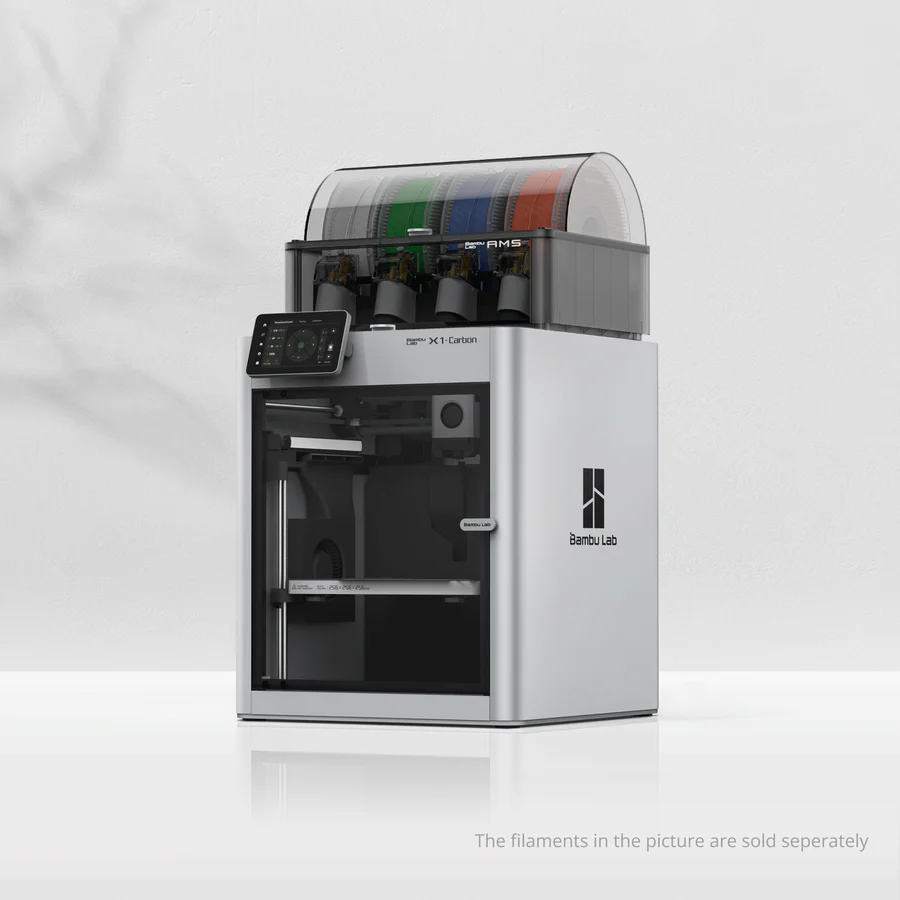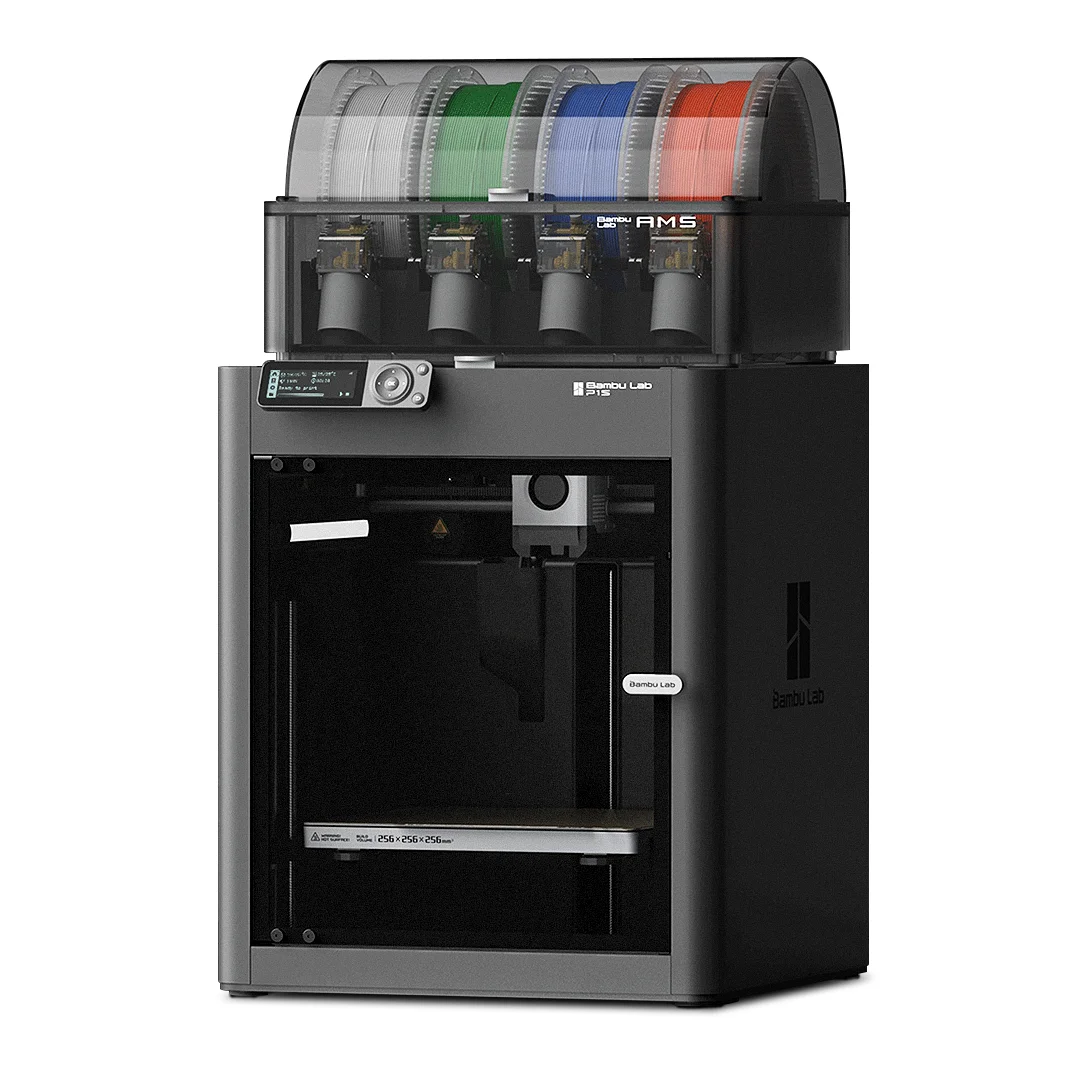Compare X1 carbon vs P1S
Comparison between the best 3D printers
Choose the best 3D printer at the best price. The cheapest 3D printers are here.
Buy a 3D printer here with 3D Fila.
 |
 |
|
| Model | X1 carbon |
P1S[BUY P1S] |
| Printing Material | Filament | Filament |
| Buy Filament for Bambu Lab X1 carbon | Buy Filament forBambu Lab P1S | |
| Estimated price | $1449,00 | $949,00 |
| Manufacturer | Bambu Lab | Bambu Lab |
| Release Year | 2023 | 2023 |
| Print Volume [mm] | 256x256x256 | 256x256x256 |
| Printer Size [mm] | 389x389x457 | 389x389x458 |
| Weight [kg] | 14,13 | 12,95 |
| Power Loss Recovery | YES | YES |
| Enclosed printer | YES | YES |
| Bed Leveling | Automatic | Automatic |
| Filament End Sensor | YES | YES |
| Bed type | Heated | Heated |
| Power supply system | Direct Drive | Direct Drive |
| Standard nozzle | 0,4 | 0,4 |
| Maximum Nozzle Temperature [°C] | 300 | 300 |
| Maximum Bed Temperature [°C] | 120 | 100 |
| Maximum printing speed [mm/s] | 500 | 500 |
| Filament holder | YES | YES |
| Camera for supervision | YES | YES |
| Recommended filaments | PLA, PETG, TPU, PVA, PA, PA-CF, Nylon, PC | PLA, PETG, TPU, PVA, PA, PA-CF, Nylon, PC |
| Recommended slicers | Bambu Studio, Super Slicer, Cura, Prusa Slicer, Orca | Bambu Studio, Super Slicer, Cura, Prusa Slicer, Orca |
| Maximum Resolution [mm] | 0,1 | 0,1 |
| Processor | Quad ARM A7 1.2 GHz | Quad ARM A7 1.2 GHz |
| Display | Touchscreen 5'' | Touchscreen 5'' |
| Power Supply | 350 W | 350 W |
| Connectivity | Wifi, Bambu bus, Cartão SD | Wifi, Bambu bus, Cartão SD |
| Operating systems | Windows, Linux, Macbook | Windows, Linux, Macbook |
| Date of registration in the system | 2024-04-10 | 2024-04-11 |
| Release date | 2023 | 2023 |
| Extra features | The Bambu Lab X1 Carbon revolutionizes 3D printing with stunning design, high print speeds, and a streamlined user experience. It stands out with its CoreXY system, a hotend capable of reaching 300°C, allowing for a wide range of filaments. Its LiDAR-assisted bed leveling system, vibration compensation, and AMS multicolor printing capability raise the industry standard. Print quality is impressive, with the ability to fine-tune for perfection. The X1 Carbon, with its closed build volume, not only promises but also delivers one of the most advanced 3D printing experiences available to consumers. | The Bambu Lab P1S stands out for its out-of-the-box practicality, eliminating the need for manual adjustments with automatic calibrations such as bed leveling and vibration compensation. It features multicolor printing capability through the AMS system, allowing up to 16 colors when connecting four AMS units. With an advanced control algorithm, the P1S offers fast printing speeds without sacrificing quality. Equipped with modern features such as filament end sensor, semi-automatic belt tension, direct extruder, welded frame and all-metal hotend, along with a fully enclosed chamber, the P1S promotes a superior printing experience, supporting a wide range of materials. |
| Support for multiple colors and materials (AMS and CFS) | YES | YES |
Notes * |
||
| Cost-benefit | 7 / 10 | 7 / 10 |
| Hardware | 6.4 / 10 | 6.4 / 10 |
| Tela | . | . |
| Print volume | 4 / 10 | 4 / 10 |
| Performance | 4 / 10 | 4 / 10 |
| [BUY P1S] |
Conclusion |
| In comparing the Bambu Lab X1 Carbon and the P1S, both printers demonstrate impressive capabilities and advanced features in the 3D printing market. The X1 Carbon, positioned at a higher price point, offers exceptional specifications, including a wider maximum bed temperature, and is designed with enhanced precision and user experience in mind, thanks to features like LiDAR-assisted bed leveling and vibration compensation. Its focus on print quality and versatility solidifies its place at the premium end of the spectrum. On the other hand, the P1S provides significant value for a lower price, with many features that mirror those of the X1 Carbon, including multicolor printing capabilities and a fully enclosed chamber. The P1S's strengths lie in its out-of-the-box practicality and ease of use, making it a solid choice for users who prioritize cost-effectiveness without sacrificing quality. Ultimately, the decision between the two models hinges on the user's specific needs and budget. For those seeking top-tier performance and advanced features and willing to invest more, the X1 Carbon is an excellent option. However, the P1S stands out as an exceptional value proposition for those looking for a robust printer at a more accessible price, particularly for users who value ease of setup and operation. In summary, both printers are commendable, but the P1S offers a better cost-benefit ratio, while the X1 Carbon excels in advanced capabilities and print precision. |

